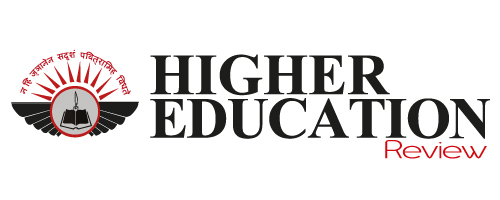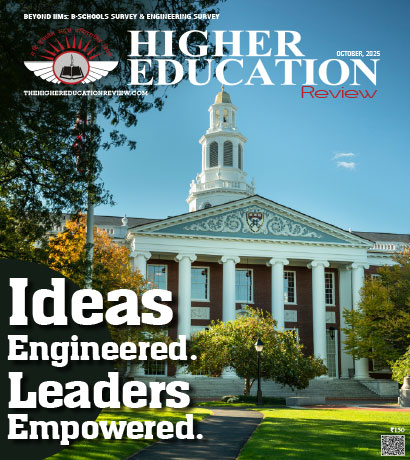Three ways to Steer Talent development in a Fast-Changing Technological Environment
 Salil Chinchore, CHRO, Elastic Run in a recent interaction with Higher Education Review magazine, shared his views on how organizations can balance upskilling existing talent with recruiting new employees equipped with cutting-edge skills, what strategies can HR leaders employ to create cohesive learning cultures in hybrid or fully remote setups and more. Salil Chinchore brings 25 years of extensive experience in Human Resources and General Management across renowned organizations. He has successfully led HR functions in key areas including Organization Strategy & Design, Talent and Leadership Development, Employee Engagement, Global HR, Labor Relations & Collective Bargaining, Change Management, and Mergers & Acquisitions.
Salil Chinchore, CHRO, Elastic Run in a recent interaction with Higher Education Review magazine, shared his views on how organizations can balance upskilling existing talent with recruiting new employees equipped with cutting-edge skills, what strategies can HR leaders employ to create cohesive learning cultures in hybrid or fully remote setups and more. Salil Chinchore brings 25 years of extensive experience in Human Resources and General Management across renowned organizations. He has successfully led HR functions in key areas including Organization Strategy & Design, Talent and Leadership Development, Employee Engagement, Global HR, Labor Relations & Collective Bargaining, Change Management, and Mergers & Acquisitions.
• The shift toward understanding how to interpret and draw meaningful conclusions from the data analytics provided by AI tools and how to take decisions from that analytics.
• How self-paced learning can be practiced even remotely as it does not require people to come together.
• How can organizations design continuous learning programs that anticipate and adapt to future technological trends.
With the rise of generative AI and automation, many traditional roles are being redefined. How can organizations balance upskilling existing talent with recruiting new employees equipped with cutting-edge skills?
With generative AI and other technological tools that are available, gathering and analyzing the information is going to become easy and due to this, it is possible that the jobs which are very repetitive in nature, jobs which are primarily designed to collect information or data, are going to become redundant. Jobs which primarily carry out data analysis or data analytics will also be severely impacted.
For students, this means the focus will shift toward understanding how to interpret and draw meaningful conclusions from the data analytics provided by AI tools. And how do you take decisions from that analytics? And this will be critical. Thus, whether it is organizations, how do they train their employees to leverage AI to analyze data, analyze information, and take decisions is something the organizations will have to do. When they look at hiring students, they will have to look at the capability of using the information provided by AI to make decisions.
Remote work has reshaped the dynamics of team collaboration and learning. What strategies can HR leaders employ to create cohesive learning cultures in hybrid or fully remote setups?
Companies are aware of the kind of challenges remote working has brought in. It comes in the way of connecting with the colleagues, it comes in the way of collaborating with colleagues, it comes in the way of learning together. Therefore, there is certain training or learning methodology which can take place even in remote settings. For instance, self-paced learning can be practiced even remotely as it does not require people to come together.
However, there are skill-based programs, and behavior-based programs which require people to come together to work in small groups. Those are the programs where companies today are finding it difficult to conduct as it requires them to gather people in smaller cohorts. The other segment where companies are now trying to leverage technology is to conduct even team-based programs in a virtual format.
Thus, today all the collaboration tools such as MS Teams and Zoom, also provide ways to facilitate the training to a larger group, virtually. Now, this may mean breakout rooms, conducting polls and white boarding activities. A lot of those features are now available on online collaboration tools as well and a myriad of companies are leveraging these tools. During the COVID pandemic, I had the opportunity to complete my coaching accreditation course, which was conducted online. There were 15 participants in my batch, and the entire program was delivered through virtual sessions. At no point did we feel disconnected or as though we were not in the same location. This demonstrates that a skilled facilitator, when utilizing the right tools, can effectively conduct such programs virtually.
Rapid technological advancements often lead to skills obsolescence faster than ever. How can organizations design continuous learning programs that anticipate and adapt to future technological trends?
Technological cycles do not impact organizations overnight. When a new technology emerges, such as generative AI, it is often first piloted and tested in the market. Organizations typically wait for proof of success and relevance before considering its adoption. Initially, they experiment with the technology in specific areas, assessing its value. Once the technology is recognized as relevant and an enabler of business strategies, the company integrates it into their existing systems. It is at this later stage, when the technology is implemented organization-wide, that its impact on employees and their skill sets becomes evident.
Companies that are into tech domain and whose main purpose of doing business is to build technology products get impacted first. Some of the non-technical product companies like FMCG engineering do not get affected much compared to tech companies as technology is only a part of their business. Therefore, technology companies must approach this with a high degree of seriousness and strategic focus.
They will have to continuously scan the environment and see what are the new technologies that are of getting piloted in the space, what the competition is doing, how the competitors are playing with technology and how it is going to impact us internally. It is very important to share this transparently with the employees and tell them what is coming their way. Most of the companies also make training and learning platforms available for people to continuously upskill and upgrade them on the new emerging technologies.
What key insights or message would you like to convey to our readers?
As a leader, I believe there are three key responsibilities for navigating this effectively. Firstly, leaders should move beyond relying only on their technology teams. Whether you are a functional head, business leader or organizational strategist, it is important to scan the environment actively for advanced technologies and build an informed perspective on how they may either positively or negatively impact the organization.
Secondly, it is important to develop a deep understanding of technology. Here a common challenge that most leaders face today is a lack of clear understanding of the capabilities as well as implications of new technologies and this is critical to invest time in learning and where possible to engage directly with these innovations in order to comprehend their true potential as well as limitations.
The last and the most important insight is to bring your team along the journey. Change is highly effective only when leaders carry their teams through it. It is vital to help employees become emotionally as well as intellectually prepared for understanding as well as embracing new technologies. Building this readiness helps in ensuring smoother transitions as well as greater organizational resilience.
Leaders can better equip their organizations to thrive in this fast-evolving and technology driven world by fulfilling the aforementioned responsibilities.

